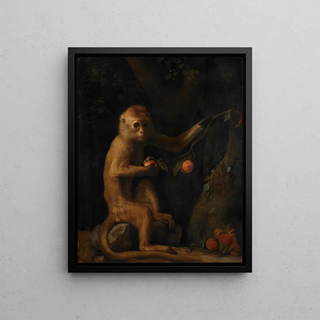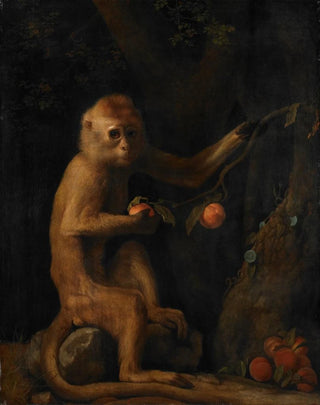Art print | A monkey - George Stubbs


View from behind

Frame (optional)
The artwork "Un singe" by George Stubbs is an invitation to immerse oneself in the fascinating world of 18th-century British painting. This painting, depicting a monkey in a pose that is both curious and expressive, transports us to an era where art and science intertwined harmoniously. Stubbs, renowned for his meticulous approach and keen observational skills, manages to capture the unique personality of this animal, revealing an almost human dimension through its gaze. This piece, with its apparent simplicity, embodies a depth that invites reflection on nature and the animal condition.
Style and uniqueness of the artwork
Stubbs' style is distinguished by its striking realism and attention to detail. In "Un singe," every hair, every shadow is carefully rendered, demonstrating impeccable technique. The artist does not merely reproduce the physical appearance of his subject; he also explores the psychology of the animal. The piercing gaze of the monkey, combined with its posture, creates an almost intimate interaction with the viewer. Stubbs succeeds in transcending the simple animal portrait to offer a work that evokes empathy and wonder. This ability to humanize his subjects while respecting their animal essence is one of the characteristics that make Stubbs a master of his time.
The artist and his influence
George Stubbs is often regarded as the pioneer of modern animal painting. His work is not limited to the depiction of horses, although he gained fame for his equine portraits. Stubbs also captured the diversity of the animal kingdom, and "Un singe" is a shining example. His scientific approach, influenced by his anatomical studies, allows him to portray animals with unparalleled precision. Stubbs' influence extends far beyond his era; he inspired many contemporary and future artists, who saw in him a model of observation and technique. His ability to marry art and science paved the way for a new appreciation of nature in art, a legacy that endures to this day.
An exceptional wall decoration signed Artem Legrand
Owning a reproduction of

Matte finish

View from behind

Frame (optional)
The artwork "Un singe" by George Stubbs is an invitation to immerse oneself in the fascinating world of 18th-century British painting. This painting, depicting a monkey in a pose that is both curious and expressive, transports us to an era where art and science intertwined harmoniously. Stubbs, renowned for his meticulous approach and keen observational skills, manages to capture the unique personality of this animal, revealing an almost human dimension through its gaze. This piece, with its apparent simplicity, embodies a depth that invites reflection on nature and the animal condition.
Style and uniqueness of the artwork
Stubbs' style is distinguished by its striking realism and attention to detail. In "Un singe," every hair, every shadow is carefully rendered, demonstrating impeccable technique. The artist does not merely reproduce the physical appearance of his subject; he also explores the psychology of the animal. The piercing gaze of the monkey, combined with its posture, creates an almost intimate interaction with the viewer. Stubbs succeeds in transcending the simple animal portrait to offer a work that evokes empathy and wonder. This ability to humanize his subjects while respecting their animal essence is one of the characteristics that make Stubbs a master of his time.
The artist and his influence
George Stubbs is often regarded as the pioneer of modern animal painting. His work is not limited to the depiction of horses, although he gained fame for his equine portraits. Stubbs also captured the diversity of the animal kingdom, and "Un singe" is a shining example. His scientific approach, influenced by his anatomical studies, allows him to portray animals with unparalleled precision. Stubbs' influence extends far beyond his era; he inspired many contemporary and future artists, who saw in him a model of observation and technique. His ability to marry art and science paved the way for a new appreciation of nature in art, a legacy that endures to this day.
An exceptional wall decoration signed Artem Legrand
Owning a reproduction of






